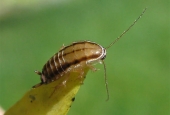Brown-banded Cockroach (Supella longipalpa)
This rarely encountered cockroach species is similar in appearance to the German cockroach but its habits are much different.
They are light to dark brown in color and about ½ to 5/8 inch in length. They have two light colored bands along their wings and abdomen, whereas the German cockroach has two dark, distinctive bands behind their head.
Unlike the German cockroach, this species prefers hot, dry areas and can be found anywhere in a building or home. They are often found in bedrooms and living rooms, infesting furniture, behind picture frames, or on ceilings. Males have wings that cover the abdomen and will readily fly when disturbed. Their diet includes starchy non-food items such as wall paper paste and book bindings.
Female Brown-banded cockroaches carry between 14 and 18 eggs in an external egg case. In two months the young develop into adults. Adults can live up to ten months, and a single females can produce approximately 14 egg cases or 250 offspring in her lifetime.
Control of this cockroach can be challenging, so it is advisable to hire a pest control professional for proper identification and treatment.
Turkestan Cockroach (Blatta lateralis)
The Turkestan cockroach is very similar to the Oriental cockroach in appearance and behavior. The adult female is about 1 inch long with cream-colored markings along the edges behind the head and around the short, rounded wings. Males are slightly smaller with yellowish-tan wings and cream-colored stripes along the edges. Male Turkestan cockroaches are capable of flying and are attracted to exterior lights.
This recently introduced cockroach species has habits similar to the Oriental cockroach. It typically is found outdoors in areas such as water meter boxes, under concrete pavements, compost piles or leaf litter, it may occasionally enter homes.
Control methods are the same as those for the Oriental and American cockroaches. If there is a persistent problem, seal doors and other openings into the building or residence.
Three-lined Cockroach (Luridiblatta trivittata)
Native to dry areas of the Mediterranean, the Three-lined cockroach was first recorded in Marin and Sonoma counties in 2004. They are now found in many Bay Area counties, including Alameda County. This small (1/4”), wingless cockroach is very similar in appearance to a German cockroach nymph, but has three dark lines instead of two.
This cockroach is found in leaf litter and plant debris, mulch and compost piles. Though primarily an outdoor species, it will enter homes, especially in late summer.
Reducing plant debris, mulch piles and vegetation around the home may help reduce the numbers of this cockroach.





